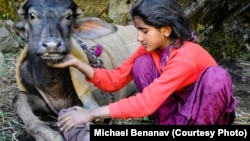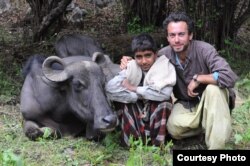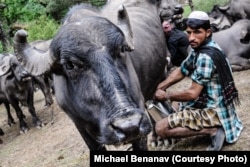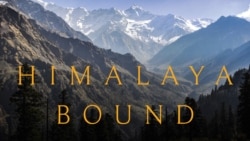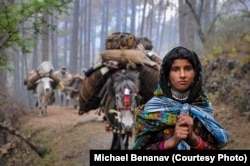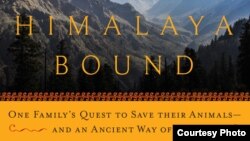Michael Benanav has traveled around much of the world, chronicling in words and pictures nomadic communities from Mali, to Jordan, to Mongolia. But when the American photographer heard about the Van Gujjar tribe of Northern India, he knew he wanted to do more than just document their existence. He wanted to join them on a migration to better understand their traditional way of life.
Forest-dwelling Van Gujjars
For 44 days, Benanav embedded himself with a family, and through the help of a translator, set about learning all he could about their nomadic, forest-dwelling lifestyle.
“It was partly because I just thought it would be a fascinating experience," he explained. "And also because it seemed really critical to just understand their nomadic way of life.”
One of the first things Benanav noticed right away was how welcoming the Van Gujjars were toward him.
“They really invited me and welcomed me into their world, and really was taken into the family with an incredible amount of warmth and trust,” he said. “My work has taken me [to] many places in the world, meeting many different kinds of people, and there was something about this family that really touched me in a way that was quite unique,” he added.
An animal-loving community
Benanav said that while the Van Gujjars are Muslim, he found them to be among the more liberal communities in India, especially the women.
“Even though I was a man coming in from the outside, there were no barriers whatsoever to me talking to, hanging out with, spending time with the women in the family,” he said. “It was a very well-integrated situation gender-wise.”
Benanav also noticed how devoted tribe members were not only to each other, but to their herd of water buffalo around which their lives revolved. Understanding that profound connection to their animals, he said, is fundamental to understanding the Van Gujjars.
“They think of their buffaloes as family members. They would never eat them. They never even sell them for slaughter. And even though this is a Muslim community, they also happen to be vegetarian, not for any religious reasons, but because they really just don't like the idea of killing animals,” he said.
The family keep their buffaloes solely for the milk they produce, he explained, which they use for their own consumption within the family. They sell what's left over, and use that money to buy anything else that they need. “They really love these animals,” he emphasized.
That love for their animals manifested itself in many ways.
“Every Van Gujjar buffalo has a name. Every buffalo they say has a unique personality. If a buffalo was to get sick, the family would be really wracked with concern. And if a buffalo dies, they’ll bury it and mourn for it almost as if it was human.”
Sacred lands
Spending time with the family gave Benanav an opportunity to also learn about the tribe's migration patterns.
“The Van Gujjars practice a form of seasonal migration,” he explained. “They live all year in the wilderness. In the fall and the winter, they live in an area called the Sivalik Hills, which is a chain of low but very rugged hills in North India that is covered by a thick, junglely kind of forest which provides plenty of food for the buffaloes during that time of the year.”
By April, it starts to get so hot that there's nothing left for the buffaloes to eat or drink there, he said, which means that in order to survive, they have to trek to a cooler climate up in the Himalayas.
“Because while in the lowlands the forest is wilting in heat, what's happening up in the highlands is the snows are melting, revealing these great grassy meadows where there's plenty of food and water to sustain the buffaloes all summer long,” he said. “So, they really follow this cycle of natural seasonal migration based on where they can find food and water for their animals.”
But the tribe’s ancestral homelands are becoming less accessible to them as the land is incorporated into national parks and wildlife sanctuaries.
“Some of them have already been forcibly evicted from the forests where they and their ancestors have lived for over 1,000 years,” Benanav observed. “And others are today facing that same kind of pressure.”
And that is having a major impact on the Van Gujjar tribe members and other nomadic communities around the world.
“Whether it's Navajo people, or whether it's the nomadic Van Gujjars, or whether it's the Alevi Kurds in Turkey — there’s a really profound relationship with the natural world,” Benanav said. “Maybe some of that comes from the fact they're living really in intimate contact with the natural world but also their perspective on it as something that is essentially sacred.”
It's often forgotten, the photographer noted, that people have been living on wild lands for generations.
“To the typical American mentality, national parks are created on these pristine wild lands where people don't live. It's a place where these amazing landscapes are being protected from development,” he said. “But that’s because here in the United States, the indigenous people were evicted from the areas that became national parks 100-plus years ago already.”
He cited America’s Yellowstone National Park as an example.
“So, this whole idea of people evicting from parks is known as the ‘Yellowstone model,’ because that was the place where it was first pioneered.”
PHOTO BLOG: See more of Michael Benanav's photos
Tolerance
“And that really gets to one of the more complicating factors in this whole idea of evicting indigenous people from parks, which is that we tend to have an idea that nature in its pure form — untouched, pristine, unaffected by man — is what we are protecting in national parks. But the reality is that many of these places, including Yellowstone … were essentially curated and managed by indigenous people for thousands of years before European people ever encountered them or discovered them,” he said.
Benanav said his experiences have helped him appreciate the diversity that exists in so many cultures around the globe.
“I really value the legacy that different peoples around the world bring to our humanity today,” he said. “And as the world becomes a more homogenized place, I think it's really important to be remembering all of the different possible ways that it is to be human.”
Benanav has chronicled his experience with the Van Gujjars in his latest book "Himalaya Bound," which he hopes will expand the world of his readers.
“Once you’ve seen or read about people who for example are willing to save the life of a buffalo with a broken leg and carry it over the Himalayas, you don't forget that,” he noted. “And your world is bigger for that, and I think your world is richer for that.”
“And whether it's from the Van Gujjars, or whether it’s the Navajos, or whether it’s any of the other communities that I've been working on documenting, I think each of our worlds is a richer place for knowing about these different cultures and the ways that they live and the things that they value,” he concluded.




